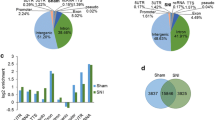Abstract
RNA sequencing (RNA-seq), chromatin immunoprecipitation sequencing (ChIP-seq), and assay for transposase-accessible chromatin sequencing (ATAC-seq) are genome-wide techniques that provide information relative to gene expression, chromatin binding sites, and chromatin accessibility, respectively. Here we describe RNA-seq, H3K9ac, H3K27ac and H3K27me3 ChIP-seq, and ATAC-seq in dorsal root ganglia (DRG) after sciatic nerve or dorsal column axotomy, to characterize the transcriptional and epigenetic signatures of DRG upon regenerative vs non-regenerative axonal lesion.
Access this chapter
Tax calculation will be finalised at checkout
Purchases are for personal use only
Similar content being viewed by others
References
Wang Z, Gerstein M, Snyder M (2009) RNA-seq: a revolutionary tool for transcriptomics. Nat Rev Genet 10(1):57–63. https://doi.org/10.1038/nrg2484
Schmidt D, Wilson MD, Spyrou C, Brown GD, Hadfield J, Odom DT (2009) ChIP-seq: using high-throughput sequencing to discover protein-DNA interactions. Methods 48(3):240–248. https://doi.org/10.1016/j.ymeth.2009.03.001
Buenrostro JD, Giresi PG, Zaba LC, Chang HY, Greenleaf WJ (2013) Transposition of native chromatin for fast and sensitive epigenomic profiling of open chromatin, DNA-binding proteins and nucleosome position. Nat Methods 10(12):1213–1218. https://doi.org/10.1038/nmeth.2688
Hervera A, De Virgiliis F, Palmisano I, Zhou L, Tantardini E, Kong G, Hutson T, Danzi MC, Perry RB, Santos CXC, Kapustin AN, Fleck RA, Del Rio JA, Carroll T, Lemmon V, Bixby JL, Shah AM, Fainzilber M, Di Giovanni S (2018) Reactive oxygen species regulate axonal regeneration through the release of exosomal NADPH oxidase 2 complexes into injured axons. Nat Cell Biol 20(3):307–319. https://doi.org/10.1038/s41556-018-0039-x
Hervera A, Zhou L, Palmisano I, McLachlan E, Kong G, Hutson TH, Danzi MC, Lemmon VP, Bixby JL, Matamoros-Angles A, Forsberg K, De Virgiliis F, Matheos DP, Kwapis J, Wood MA, Puttagunta R, Del Rio JA, Di Giovanni S (2019) PP4-dependent HDAC3 dephosphorylation discriminates between axonal regeneration and regenerative failure. EMBO J. https://doi.org/10.15252/embj.2018101032
Palmisano I, Danzi MC, Hutson TH, Zhou L, McLachlan E, Serger E, Shkura K, Srivastava PK, Hervera A, Neill NO, Liu T, Dhrif H, Wang Z, Kubat M, Wuchty S, Merkenschlager M, Levi L, Elliott E, Bixby JL, Lemmon VP, Di Giovanni S (2019) Epigenomic signatures underpin the axonal regenerative ability of dorsal root ganglia sensory neurons. Nat Neurosci 22(11):1913–1924. https://doi.org/10.1038/s41593-019-0490-4
Conesa A, Madrigal P, Tarazona S, Gomez-Cabrero D, Cervera A, McPherson A, Szczesniak MW, Gaffney DJ, Elo LL, Zhang X, Mortazavi A (2016) A survey of best practices for RNA-seq data analysis. Genome Biol 17:13. https://doi.org/10.1186/s13059-016-0881-8
Kaya-Okur HS, Wu SJ, Codomo CA, Pledger ES, Bryson TD, Henikoff JG, Ahmad K, Henikoff S (2019) CUT&Tag for efficient epigenomic profiling of small samples and single cells. Nat Commun 10(1):1930. https://doi.org/10.1038/s41467-019-09982-5
Li Z, Schulz MH, Look T, Begemann M, Zenke M, Costa IG (2019) Identification of transcription factor binding sites using ATAC-seq. Genome Biol 20(1):45. https://doi.org/10.1186/s13059-019-1642-2
Kim D, Pertea G, Trapnell C, Pimentel H, Kelley R, Salzberg SL (2013) TopHat2: accurate alignment of transcriptomes in the presence of insertions, deletions and gene fusions. Genome Biol 14(4):R36. https://doi.org/10.1186/gb-2013-14-4-r36
Langmead B, Salzberg SL (2012) Fast gapped-read alignment with Bowtie 2. Nat Methods 9(4):357–359. https://doi.org/10.1038/nmeth.1923
Robinson MD, McCarthy DJ, Smyth GK (2010) edgeR: a bioconductor package for differential expression analysis of digital gene expression data. Bioinformatics 26(1):139–140. https://doi.org/10.1093/bioinformatics/btp616
Ritchie ME, Phipson B, Wu D, Hu Y, Law CW, Shi W, Smyth GK (2015) limma powers differential expression analyses for RNA-sequencing and microarray studies. Nucleic Acids Res 43(7):e47. https://doi.org/10.1093/nar/gkv007
Nakato R, Sakata T (2021) Methods for ChIP-seq analysis: a practical workflow and advanced applications. Methods 187:44–53. https://doi.org/10.1016/j.ymeth.2020.03.005
Yan F, Powell DR, Curtis DJ, Wong NC (2020) From reads to insight: a hitchhiker’s guide to ATAC-seq data analysis. Genome Biol 21(1):22. https://doi.org/10.1186/s13059-020-1929-3
Gusmao EG, Allhoff M, Zenke M, Costa IG (2016) Analysis of computational footprinting methods for DNase sequencing experiments. Nat Methods 13(4):303–309. https://doi.org/10.1038/nmeth.3772
Baek S, Goldstein I, Hager GL (2017) Bivariate genomic footprinting detects changes in transcription factor activity. Cell Rep 19(8):1710–1722. https://doi.org/10.1016/j.celrep.2017.05.003
Acknowledgments
The work has been supported by the Wings for Life (SDG), Rosetrees Trust (SDG), Leverhulme Trust (SDG), International Spinal Research Trust (SDG), Brain Research UK (SDG), and Medical Research Council (SDG). The schematics have been generated using BioRender (BioRender.com).
Author information
Authors and Affiliations
Corresponding author
Editor information
Editors and Affiliations
Rights and permissions
Copyright information
© 2023 The Author(s), under exclusive license to Springer Science+Business Media, LLC, part of Springer Nature
About this protocol
Cite this protocol
Müller, F., Chadwick, J.S., Di Giovanni, S., Palmisano, I. (2023). Epigenomic Profiling of Dorsal Root Ganglia upon Regenerative and Non-regenerative Axonal Injury. In: Udvadia, A.J., Antczak, J.B. (eds) Axon Regeneration. Methods in Molecular Biology, vol 2636. Humana, New York, NY. https://doi.org/10.1007/978-1-0716-3012-9_7
Download citation
DOI: https://doi.org/10.1007/978-1-0716-3012-9_7
Published:
Publisher Name: Humana, New York, NY
Print ISBN: 978-1-0716-3011-2
Online ISBN: 978-1-0716-3012-9
eBook Packages: Springer Protocols




